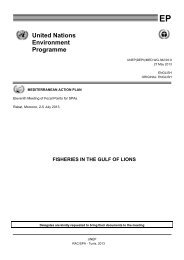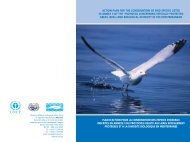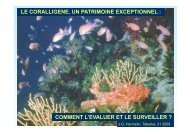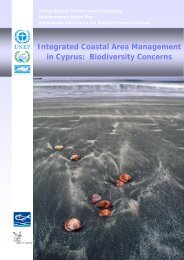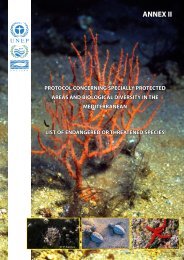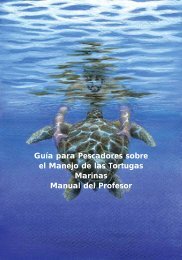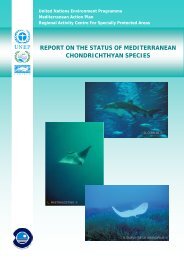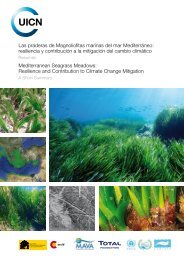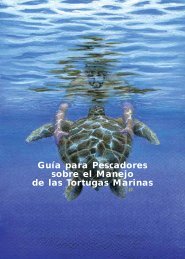Proceedings of the Second Mediterranean Symposium on Marine
Proceedings of the Second Mediterranean Symposium on Marine
Proceedings of the Second Mediterranean Symposium on Marine
You also want an ePaper? Increase the reach of your titles
YUMPU automatically turns print PDFs into web optimized ePapers that Google loves.
PROCEEDINGS OF THE SECOND MEDITERRANEAN SYMPOSIUM ON MARINE VEGETATION (ATHENS, 12-13 DECEMBER 2003)<br />
176<br />
This study aims at appreciating <str<strong>on</strong>g>the</str<strong>on</strong>g> use <str<strong>on</strong>g>of</str<strong>on</strong>g> Posid<strong>on</strong>ia oceanica for <str<strong>on</strong>g>the</str<strong>on</strong>g> evaluati<strong>on</strong> <str<strong>on</strong>g>of</str<strong>on</strong>g> <str<strong>on</strong>g>the</str<strong>on</strong>g><br />
actual and past envir<strong>on</strong>ment quality.<br />
MATERIALS AND METHODS<br />
The study is realised in three sites <str<strong>on</strong>g>of</str<strong>on</strong>g> <str<strong>on</strong>g>the</str<strong>on</strong>g> Corsican littoral (Bastia, Lumio, Macinaggio;<br />
Fig. 1), characterized by different quality levels (Ifremer, 1994).<br />
10 orthotropic shoots <str<strong>on</strong>g>of</str<strong>on</strong>g> Posid<strong>on</strong>ia oceanica are sampled, by scuba diving, at -10 meters,<br />
in 2002, in each site. A lepidochr<strong>on</strong>ological analysis is realised. This technique, related to<br />
<str<strong>on</strong>g>the</str<strong>on</strong>g> dendrochr<strong>on</strong>ology, allows to date <str<strong>on</strong>g>the</str<strong>on</strong>g> scales (or old foliar petioles) which persist<br />
al<strong>on</strong>g <str<strong>on</strong>g>the</str<strong>on</strong>g> rhizomes (Pergent, 1990). Scales and rhizomes c<strong>on</strong>stitute <str<strong>on</strong>g>the</str<strong>on</strong>g> belowground<br />
part <str<strong>on</strong>g>of</str<strong>on</strong>g> <str<strong>on</strong>g>the</str<strong>on</strong>g> plant.<br />
Fig. 1: Localizati<strong>on</strong> <str<strong>on</strong>g>of</str<strong>on</strong>g> <str<strong>on</strong>g>the</str<strong>on</strong>g> studied sites (SHOM).<br />
At <str<strong>on</strong>g>the</str<strong>on</strong>g> end <str<strong>on</strong>g>of</str<strong>on</strong>g> <str<strong>on</strong>g>the</str<strong>on</strong>g> treatment, a series <str<strong>on</strong>g>of</str<strong>on</strong>g> rhizomes secti<strong>on</strong>s and <str<strong>on</strong>g>the</str<strong>on</strong>g> corresp<strong>on</strong>ding scales lots are<br />
obtained, each secti<strong>on</strong>/lot corresp<strong>on</strong>ding to a lepidochr<strong>on</strong>ological year (Pergent, 1990). The<br />
samples (scales and rhizomes) are frozen (-20° C), frozen-dry (>72 h) and <str<strong>on</strong>g>the</str<strong>on</strong>g>n reduced in<br />
powder. After microwave digesti<strong>on</strong> in closed vessel (Ferrat et al., 2002), <str<strong>on</strong>g>the</str<strong>on</strong>g> mercury is<br />
measured by flameless atomic absorpti<strong>on</strong> spectrometry (FIMS 100, Perkin Elmer®).<br />
RESULTS<br />
The measured mercury c<strong>on</strong>centrati<strong>on</strong>s vary in functi<strong>on</strong> <str<strong>on</strong>g>of</str<strong>on</strong>g> <str<strong>on</strong>g>the</str<strong>on</strong>g> tissue, <str<strong>on</strong>g>the</str<strong>on</strong>g> year and <str<strong>on</strong>g>the</str<strong>on</strong>g> site.<br />
• Influence <str<strong>on</strong>g>of</str<strong>on</strong>g> <str<strong>on</strong>g>the</str<strong>on</strong>g> tissue<br />
A significant difference <str<strong>on</strong>g>of</str<strong>on</strong>g> <str<strong>on</strong>g>the</str<strong>on</strong>g> mercury c<strong>on</strong>centrati<strong>on</strong>s is observed between <str<strong>on</strong>g>the</str<strong>on</strong>g> two<br />
studied tissues, all sites and years mingled, with higher values in <str<strong>on</strong>g>the</str<strong>on</strong>g> rhizomes (Kruskall<br />
Wallis, p = 0.000056; Table 1). This difference is also observed, all sites mingled, for <str<strong>on</strong>g>the</str<strong>on</strong>g><br />
years 1998 to 2001 (ANOVA; Table 1). The c<strong>on</strong>centrati<strong>on</strong>s in <str<strong>on</strong>g>the</str<strong>on</strong>g> rhizomes are here still<br />
higher than in <str<strong>on</strong>g>the</str<strong>on</strong>g> scales, except for 1998.




